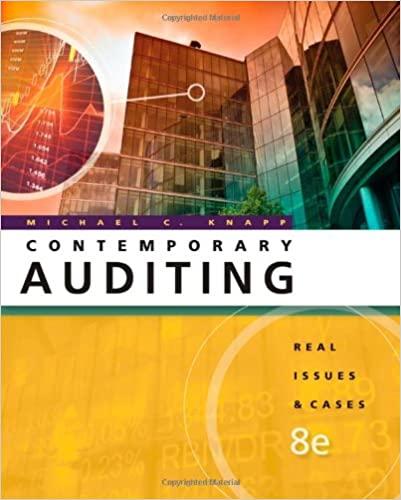Question
1a. An investor buys 500 shares of stock on Jan. 2, 2013 for $35,000. On November 1, 2013 the investor buys an additional 500 shares
1a. An investor buys 500 shares of stock on Jan. 2, 2013 for $35,000. On November 1, 2013 the investor buys an additional 500 shares for $25,000. On November 28, the investor sells 500 shares for $27,000. The investor identifies the shares purchased on Jan. 2 as those sold.
What is the amount of the gain/loss on the transaction?
Is the loss currently deductible?
On December 31, 2013 what is the basis of the stock acquired on November 1? How did you determine the basis of the shares?
What is the holding period of the stock acquired on Nov.1 on December 31?
1b. Describe 2 methods that a taxpayer can utilize to avoid the wash sale rules that minimizes the pre-tax economic effects?
Investor A owns 1,000 shares of XYZ stock. Investor A buys 10 call options on XYZ stock. Investor B also owns 1,000 shares of XYZ stock and sells 10 call options on XYZ stock. As basis in his shares is $20,000 and Bs basis in her shares is $12,000. Both A and B owned their shares for 5 years prior to entering into any of the option transactions. A exercises his options and B is assigned on her options. Both A and B have 100,000 of short-term capital gains and $75,000 of long-term capital gains from other unrelated transactions. Both A and B are in the highest marginal tax bracket. The options were exercised on the day that they expired. The options are listed and have the following terms:
1c.
XYZ 75 July - The price quoted is $3.50.
A. Explain the terms of the options.
B. - After A exercises his options how many shares of XYZ will he own?
Will A recognize any gain or loss on these transactions?
If so, how much? What will its character be?
C. - After B is assigned on her options how many shares of XYZ will she own? What will the basis in her shares be?
Will B recognize any gain or loss on these transactions? If so, how much?
What will its character be?
1d. If XYZ was trading at $100 per share, the day before the options expired, could either of these investors have done something to enhance their tax position?
1e. An investor sells short 1,000 shares of ABC at $80 per share on July 1, 2017. On July 23, 2017, the investor makes an in-lieu- of dividend to the lender of the shares for $1 per share. On August 1, 2017 the investor buys 1,000 shares of ABC for $73 per share and delivers them to the lender on August 4, 2017 to close the short sale. What is the investors gain/loss on the short sale for federal income tax purposes? Is the gain/loss long-term or short term?
Step by Step Solution
There are 3 Steps involved in it
Step: 1

Get Instant Access to Expert-Tailored Solutions
See step-by-step solutions with expert insights and AI powered tools for academic success
Step: 2

Step: 3

Ace Your Homework with AI
Get the answers you need in no time with our AI-driven, step-by-step assistance
Get Started


